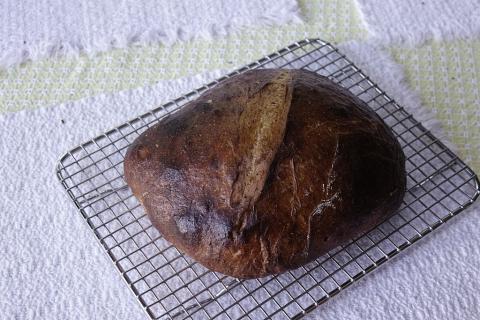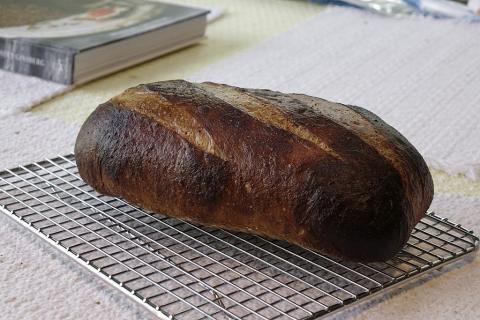
Pain Rustique Using San Joaquin Sourdough

I've been wanting to try Dave Snyder's San Joaquin formula, and I've also been wanting to try my hand at making a Pain Rustique loaf a la Prof. Calvert. So I combined the two, and it worked great.
Here's the formula, which I think has been updated a few times, with this maybe being the most recent -
https://www.thefreshloaf.com/node/53813/san-joaquin-sourdough-two-ways
I used the amounts as is, which gave me two loaves: a Pain Rustique and a small batarde. I made the levain Friday evening and let it ferment overnight on my room-temperature counter (72 - 75 deg F). Mid-morning Saturday I mixed the dough and let it ferment with about 3 S&F sessions for about 5 hours, after which it had risen more than the target 50% but less than doubled. Then the dough went into the refrigerator until the next morning.
At this point I deviated slightly from the formula because I didn't make a preform form the Pain Rustique, since the loaf itself was essentially a preform. I fermented it for 45 minutes and then baked with steam. Here is how it came out:
I don't have a photo of the crumb because I took it to our local bread bakery to share with the baker and staff, something I sometimes do (they comp me one of their loaves in return). The crumb was nicely open with a good sprinkling of larger pores. The taste was lovely, mellow, complex with hints of the whole wheat and rye. The crust was thin and crackly. It may have been cooked a little bit hot since the crust flavor was pretty strong - not burnt but strong.
I made a preform for the batarde when I formed the Rustique, and shaped it about an hour later. It proofed in about 45 minutes. The crumb of this loaf was a little tighter and more regular than the Rustique, and the flavor was the same. Here's what it looked like:
Overall I'm very happy with the results. Thanks, Dave!





Comments
What a fantastic colour on that loaf. Looks delicious.
Thanks! And it is (delicious).
I think that the color comes from a combination of a long ferment and the steaming method. The sheen comes from that, too. Too long a ferment and apparently too much of the sugars get used up, because the color will be lighter. Omit the steam and I don't get a sheen (sometimes the sheen almost looks like the loaf has been lacquered, but I don't get that consistently), and the crust will be quite different. I'm not talking about this specific formula here because I've only made this bread the once.
Here's how I steam a bake. It's pretty standard. I have a baking steel in the middle of the oven. On the bottom rack I have an oval Lodge cast iron pan. I have filled the pan with rock chips. I preheat the oven for a long time, preferably at least an hour, so all that metal gets enough time to heat up. Usually I preheat to 500 deg F (260 C). I fill a Pyrex pint measuring cup with 12 oz (340 g) tap water. I place an oven mitt close by.
I used to preheat the water to boiling in the microwave. But I don't see any difference when I use unheated tap water so I don't preheat the water any more.
After I slide the loaves onto the baking steel I close the oven door, put on the insulating mitt, pick up the Pyrex cup, open the oven door, and carefully pour as much water as I can into the cast iron pan. Then I close the oven door. Steam will billow out! Don't forget to reduce the temperature setting to the target value.
Like most consumer ovens, the steam gets vented out pretty quickly. My oven actually has a vent that directs the steam out over the cooktop. I just live with whatever steam effect I get with this. There's no way I could do anything like "steam for 12 minutes and then remove the steam apparatus".
Great looking loaves, I’d be proud of those.
Benny
Thanks, Benny!
TomP